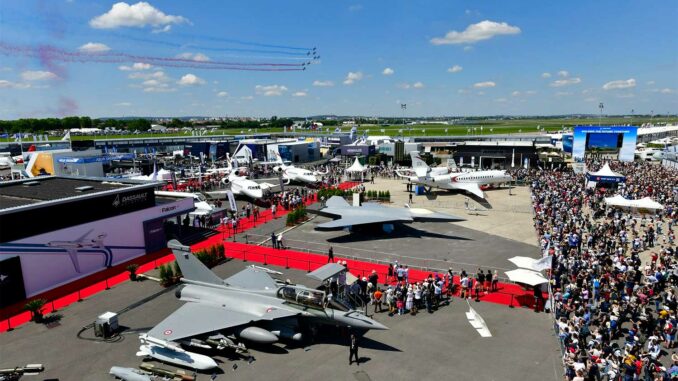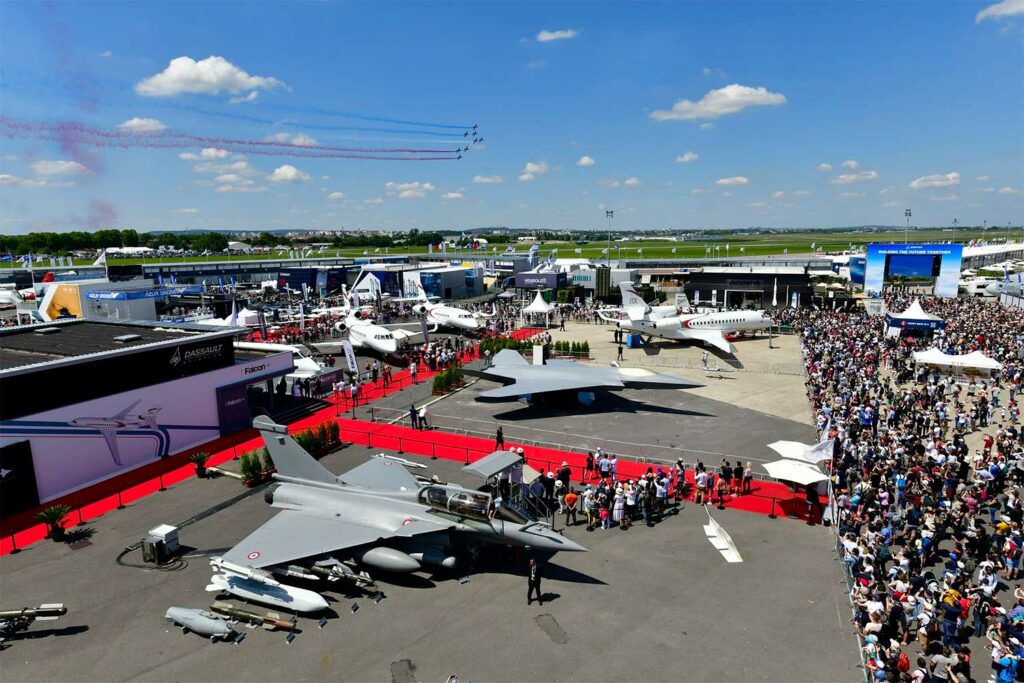
Record attendance of 45% for defense at the Paris Air Show, reflecting Europe’s response to Russian and Chinese threats.
The Paris Air Show 2025 is devoting unprecedented space to defense: 45% of the exhibition is dedicated to security, compared to around 30% in 2023. This increase comes at a time when NATO is calling for a 400% increase in air defense capabilities and a budget of 3.5–5% of GDP, particularly to counter the Russian threat. With 2,400 exhibitors and 200 military delegations expected, the event is becoming a hub for industrial, political, and strategic decision-making. Europe, whose military spending increased by 17% in 2024, is focusing on drones, missile defense, and industrial cooperation through projects such as the European Sky Shield Initiative. In short, in 2025, Le Bourget will become the venue for a global strategic turning point.
Defense exhibition: 45% of the show, a massive jump
The 2025 Paris Air Show is dedicating 45% of its exhibition space to the defense and security sectors, compared with around 30% in 2023. This 15-point increase reflects a structural shift in the aerospace industry towards military issues, driven by the increase in conventional and asymmetric conflicts since 2022. The rise of high-intensity warfare in Ukraine, the evolution of NATO doctrines on deterrence, and ongoing instability in the Middle East have reshaped the priorities of governments and manufacturers.
Technical data
The show brings together 2,400 exhibitors, including 1,110 from France, 450 from the United States, 120 from Italy, and around 100 each from the United Kingdom and Germany. At the same time, 200 official military delegations are expected, representing defense ministries, military staff and armament departments from several continents. These figures confirm Le Bourget’s growing central role as a platform for interoperability and contract negotiations for military programs.
Strategic purpose
This increase in attendance is driven by three factors: technological visibility, diplomatic outreach and capability preparation. The show serves as a neutral ground for the presentation of new weapons systems (surface-to-air missiles, MALE drones, passive radars) and as a forum for discussion on major structural programs (SCAF, ESSI, fighter fleet modernization). It is thus becoming an operational interface between defense industries, political decision-makers, and military leaders, in a context of expanding European military budgets.
Geopolitical context: war, security, budgets
The increased defense presence at the 2025 Paris Air Show comes amid a deteriorating strategic environment. Macroeconomic indicators for armaments confirm a widespread rearmament trend. In April 2025, global military spending reached $2.72 trillion (approximately €2.53 trillion), an annual increase of 9.4%, the sharpest rise since the end of the Soviet bloc. This trend is fueled by prolonged conflicts, regional diplomatic breakdowns, and the proliferation of dual-use technologies in unstable areas.
In Europe, total defense investment for 2024 amounts to $693 billion (nearly €645 billion), representing a 17% increase in one year. This threshold now exceeds the levels of military spending reached during the last decade of the Cold War. Budget increases are affecting the acquisition of heavy equipment (tanks, ground-to-air systems, combat aircraft) as well as personnel and logistical infrastructure.
Budgetary tensions and NATO doctrine
NATO Secretary General Mark Rutte has called on member countries to quintuplicate their air and missile defense capabilities. He recommends an overall budget allocation of 5% of GDP, divided between 3.5% for military deterrence and 1.5% for infrastructure and territorial resilience. This approach aims to address capability shortfalls in radar coverage, ammunition storage, and strategic mobility.
National responses
Member States are beginning to adjust their financial trajectories. The United Kingdom plans to increase its defense spending to 2.5% of GDP by 2027, with a target of 3% in the early 2030s. Germany, for its part, is undertaking a structural effort in human resources with 50,000 to 60,000 additional military recruits, aimed at strengthening its Bundeswehr in the long term. These responses confirm a doctrinal realignment in Western Europe in the face of conventional risks.

Technologies in the spotlight: missile defense systems and drones
The 2025 Paris Air Show is highlighting a generation of integrated defense systems that embody the transition to a multi-layered protection doctrine against ballistic, hypersonic, and conventional air threats. This trend is reflected in the increased presence of major manufacturers specializing in ground-to-air defense.
Ground-to-air systems on display
Among the major equipment on display:
- Raytheon is showcasing the Patriot PAC-3, a proven system capable of neutralizing aircraft, tactical missiles, and drones at ranges of up to 160 km.
- Diehl Defence is presenting the IRIS-T SLM, a vertically launched missile for medium-range air defense (up to 40 km), already operational in Ukraine.
- Missile manufacturer MBDA is exhibiting the Aster 30 integrated into the SAMP/T, capable of intercepting targets up to 120 km, including theater ballistic missiles.
- Kongsberg, in partnership with Raytheon, is promoting the NASAMS system, which can be adapted to mobile and urban environments.
European initiatives
One of the most significant projects remains the European Sky Shield Initiative (ESSI), supported by 24 European countries and aimed at pooling air defense capabilities over 3.7 million km², or nearly 70% of the EU’s territory. This system integrates several layers: IRIS-T for nearby threats, Patriot for cruise missiles, and Arrow 3 (Israel/Germany) for exo-atmospheric ballistic threats.
Emerging technologies
At the same time, manufacturers are exhibiting highly autonomous reconnaissance drones, passive radar surveillance platforms, and automated defense systems driven by embedded artificial intelligence, incorporating electromagnetic countermeasures and soft-kill neutralization modes. These innovations reflect a convergence between electronic defense, sensor autonomy, and NATO interoperability.
Industrial and strategic dimension
The 2025 Paris Air Show goes beyond its role as an exhibition to serve as a high-density industrial platform at the intersection of public policy, commercial strategy, and technological sovereignty issues. This edition comes at a time when the defense aerospace industry in France is experiencing sustained growth, fueled by international demand and pressure from European countries to modernize their equipment.
Economic weight of the defense sector
In 2024, the French defense sector generated €20.3 billion, an increase of 13% compared to the previous year. This growth was driven by exports (+19%) and accelerated domestic production (+11%). While the civilian sector remains predominant with €57.4 billion, defense now accounts for nearly 26% of the total value of the national aerospace industry. It also contributes to highly skilled industrial employment, with knock-on effects for subcontractors, design offices, and maintenance centers.
Strategic hub for negotiations
The Paris Air Show acts as a vehicle for the integration of European industries. It facilitates networking between public and private players: manufacturers, defense ministries, procurement agencies, and foreign delegations. It provides an ideal setting for the signing of letters of intent, cooperation memoranda and industrial agreements, particularly for major projects such as the SCAF, the European MALE RPAS and the ramp-up of production of the A400M and Rafale. It also serves as an indicator of confidence in the sector, with announcements expected on firm orders and extensions of multi-year contracts.
Industrial capacity constraints
This rapid growth is accompanied by severe logistical constraints. Demand for armaments, particularly for smart munitions, radars, and critical components, is creating bottlenecks in supply chains. According to several analysis firms, including Bain & Company, European industrial capabilities are currently under strain, with extended production lead times and insufficient strategic stocks. The challenge for manufacturers will therefore be to double their assembly and delivery capacities in a short time frame, while securing the supply of critical materials (composites, semiconductors, titanium).
Consequences for Europe and security
The focus of the 2025 Paris Air Show on defense issues reflects profound changes in European strategic priorities. Faced with an uncertain environment, EU and NATO member states are committed to a path of accelerated rearmament, with major budgetary, industrial, and doctrinal implications.
Massive budget reassessment
The shift to a defense effort equivalent to 5% of GDP would represent a break with post-war norms. In some countries, such as Poland and Italy, this would mean quadrupling current military budgets. For France, whose defense spending is currently around 2% of GDP, reaching 3.5% would require a 33% to 75% increase in the annual budget, depending on the assumptions made (whether or not pensions, nuclear power, and infrastructure are included). These increases would require major budgetary trade-offs, potentially affecting other key sectors.
Cooperation and interoperability
Given that it is impossible for each country to cover all the necessary capabilities (missiles, radars, fighter jets, ground-to-air defense), strategic pooling initiatives are becoming increasingly important. The European Sky Shield Initiative (ESSI) is a prime example of this: it aims to pool air defense at several levels, integrating systems such as Aster, IRIS-T, and Patriot to provide compartmentalized protection for the continent. This approach reduces redundancy, optimizes costs, and strengthens European strategic autonomy without relying exclusively on NATO architecture or US capabilities.
Persistent threats and strategic redefinition
Recent statements by Mark Rutte, who refers to a real risk of aggression within five years by Russia, confirm the pessimistic view of the security context. This uncertainty requires European countries to reconfigure their military aviation, taking into account not only attack capabilities, but also protection, surveillance, and resilience capabilities. In this context, aviation is becoming a strategic pillar, not only for deterrence, but also for crisis management (ISR, air superiority, ground-to-air defense).
At the same time, the United States, the main guarantor of the continent’s security through NATO, is exerting increasing pressure for a more equitable distribution of burdens. This dynamic could lead to a transatlantic rebalancing, calling into question certain historical industrial dependencies and accelerating the consolidation of European defense industries.
War Wings Daily is an independant magazine.